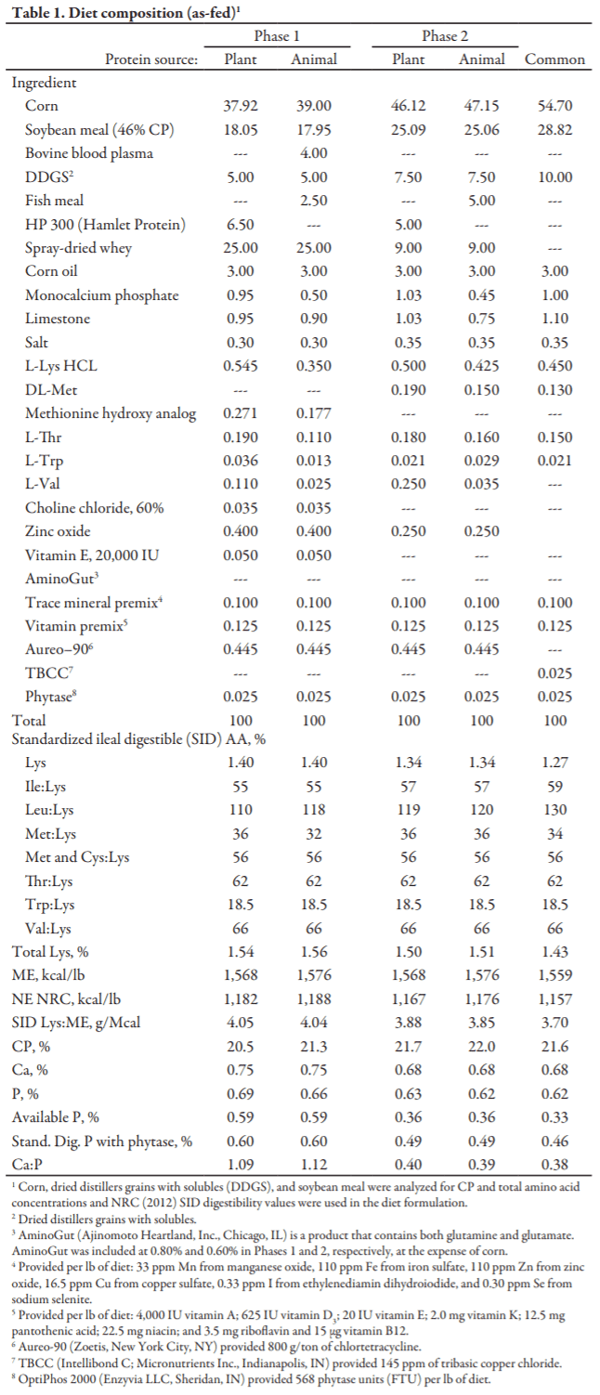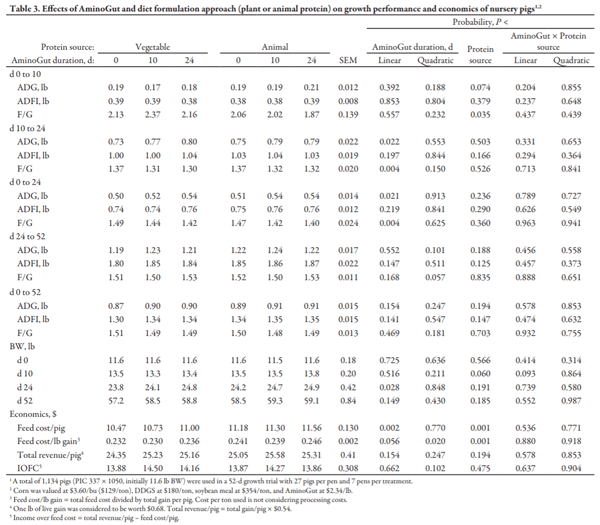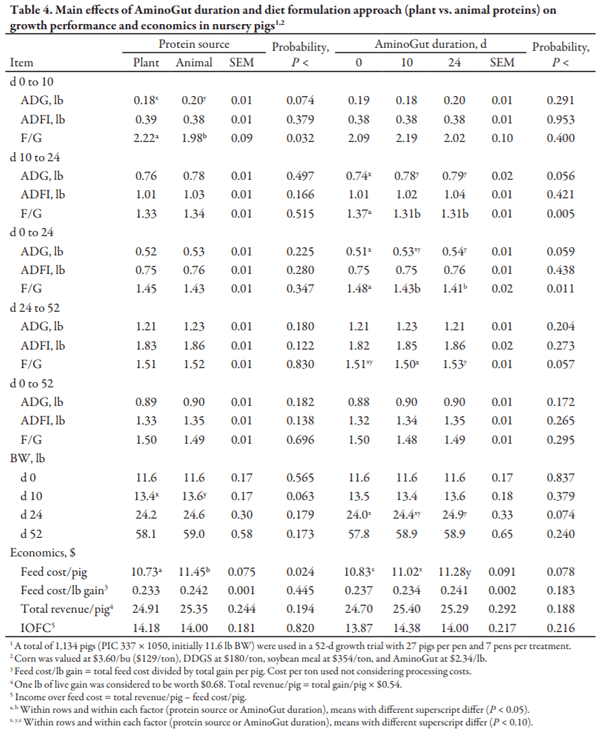Introduction
Glutamine is considered a non-essential amino acid for young pigs and is important for optimum health and function of the enterocytes in the small intestine. Glutamate is an important compound in cellular metabolism and is an energy source for the enterocytes in the intestine. Dietary glutamate may be limiting in newly-weaned pigs due to rapid turnover and replacement of mucosal cells. These are the most abundant amino acids in milk. AminoGut (Ajinomoto Heartland, Inc., Chicago, IL) is a product that contains both glutamine and glutamate. There may be a benefit of glutamine and glutamate supplementation in newly-weaned pigs on jejunal atrophy and growth performance (Wu et al., 1996; Rezaei et al., 2012; Cabrera et al., 2013). Additionally, dietary animal protein sources have greater glutamine content compared to plant protein sources. Therefore, the objective of this study was to determine the effects of AminoGut and protein source on growth performance and economic return in nursery pigs from 12 to 60 lb.
Procedures
The Kansas State University Institutional Animal Care and Use Committee approved the protocol used in this experiment. This study was conducted at a commercial research nursery barn in southwestern Minnesota. The facility was totally enclosed, environmentally controlled, and mechanically ventilated. Pens had completely slatted flooring and deep pits for manure storage. Each pen (12 × 7.5 ft) was equipped with a 6-hole stainless steel, dry self-feeder (SDI Industries, Alexandria, SD) and a pan waterer for ad libitum access to feed and water.
A total of 1,134 pigs (PIC 337 × 1050; initial BW of 11.6 ± 0.18 lb) were used in a 52-d growth trial. There were 7 pens per treatment and 27 pigs per pen. Daily feed additions to each pen were accomplished through a robotic feeding system (FeedPro; Feedlogic Corp., Willmar, MN) capable of providing and measuring feed amounts for individual pens. This system is capable of feeding each individual pen any of the individual diets as well as a blend of 2 diets.
Pens were randomly assigned within weight blocks to dietary treatments. Dietary treatments (Table 1) were arranged as a 2 × 3 factorial with 2 diet formulation approaches (animal or plant protein) and 3 feeding durations of AminoGut (0, 10, or 24 d). The AminoGut inclusion rate was 0.8% from d 0 to 10 and 0.6% from d 10 to 24. From d 24 to 52, pigs were fed a common diet. Pig BW and feed disappearance were measured on d 0, 10, 24, and 52 to calculate ADG, ADFI, and F/G.
Diet samples were taken from 6 feeders per dietary treatment 3 d after the beginning and 3 d before the end of the experiment and stored at -4°F until analyzed. Total amino acids and CP analyses were conducted on composite samples from each dietary treatment (Ajinomoto Heartland, Inc). Diet samples were also submitted for analysis of DM, crude fiber, ADF, NDF, ash, ether extract, Ca, and P (Ward Laboratories, Inc Kearney, NE).
For the economic evaluation, total feed cost per pig, cost per lb of gain, revenue, and income over feed cost (IOFC) were calculated on a pen basis. The total feed cost per pig was calculated by multiplying the ADFI by diet cost and the number of days it was fed. Cost per lb of gain was calculated by dividing the total feed cost per pig by overall pounds gained. Revenue per pig was calculated by multiplying the ADG times the total days in the trial times an assumed live price of $54.00 per cwt. To calculate IOFC, total feed cost was subtracted from pig revenue. For all economic evaluations, price of ingredients were: corn at $3.60/bu ($129/ton), DDGS at $180/ton, soybean meal at $354/ ton, L-tryptophan at $6.00/lb, L-valine at $7.50/lb, and AminoGut at $2.34/lb.
Responses measured at the pen level were analyzed using a linear mixed model. The model included the fixed effect of treatment and initial pig BW as a random effect. Pen was the experimental unit. Linear and quadratic contrasts were built to evaluate the dose response to feeding AminoGut for different durations. Statistical models were fitted using the GLIMMIX procedure in SAS (SAS Institute Inc., Cary, NC). Results were considered significant at P ≤ 0.05 and marginally significant at P ≤ 0.10.
Results and Discussion
The analyzed total amino acids, DM, CP, crude fiber, Ca, P, fat and ash contents of experimental diets (Table 2) were reasonably consistent with formulated estimates.
There were no interactions observed between protein source and AminoGut duration with the exception of BW at d 10, which was marginally heavier (P = 0.093) for pigs fed animal protein-based diet with 24 d of AminoGut duration (Table 3) compared with pigs fed vegetable-based diet with 24 d of AminoGut duration.
From d 0 to 10, pigs fed the animal protein-based diet had marginally (P = 0.074) greater ADG and improved F/G (P = 0.035) compared to pigs fed the plant-based diet. No evidence for differences was observed among pigs fed AminoGut in this phase (P > 0.188). From d 10 to 24, pigs fed AminoGut had improved ADG (linear, P < 0.022) and F/G (linear, P = 0.004). No evidence for differences was observed between protein sources in this phase. From d 24 to 52, pigs that had been previously fed AminoGut for 10 d had marginally improved F/G (quadratic, P = 0.057) compared to pigs not previously fed AminoGut or previously fed AminoGut for 24 d. No evidence for differences was observed between protein sources in this common phase.
For the combined performance from Phases I and II (d 0 to 24), pigs fed AminoGut had improved ADG (linear, P < 0.021), F/G (linear, P = 0.004), and BW (quadratic, P = 0.028) compared to pigs not fed AminoGut. No evidence for differences was observed between pigs fed different protein sources. For the overall performance (d 0 to 52), no statistical evidence for differences between pigs fed either animal- or plant-based protein source or different AminoGut durations was observed
Feed cost per pig was greater (P < 0.001) in pigs fed animal protein source compared to plant protein source. Additionally, feed cost per pig increased (linear, P = 0.002) with increasing AminoGut duration. Feed cost per lb of gain increased (quadratic, P = 0.020) with increasing duration of AminoGut supplementation and also increased (P < 0.001) in pigs fed animal protein compared to plant protein. No evidence for differences was observed in total revenue per pig or IOFC.
In conclusion, feeding AminoGut for 10 d post-weaning marginally improved growth performance until d 24 but there was no carry over effect when a common diet was fed from d 24 to 52. Further research should evaluate the supplementation of glutamine and glutamate throughout the nursery period and at greater inclusion levels.
This article was originally published in Kansas Agricultural Experiment Station Research Reports: Vol. 2: Iss. 8. https://doi.org/10.4148/2378-5977.1290. This is an Open Access article licensed under a Creative Commons Attribution 4.0 License.














